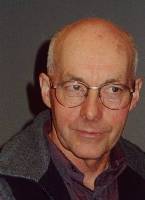


Venomous Country
Participants
Venomous Country
Endnotes
Index
Search
Help
Contact us

Alan Coulter[25]: I started at CSL back in 1970 and Struan at that time employed me as a biochemist. He was working on anti-lymphocyte globulin. The work was part of a collaboration with the Royal Melbourne Hospital on kidney transplantation, and I was to fractionate the anti-lymphocyte serum to immunoglobulin that had been raised in goats. I spent a few years doing that and gained experience in radioimmunoassay techniques, assaying anti-D immunoglobulin which was a CSL product. That led to radioimmunoassay work on snake venoms. Ken has mentioned the first description in the literature of detection of snake venom in a snakebite victim. I'll leave it at that.

Photograph courtesy of Ann Westmore
Ken Winkel: Thanks very much, Alan. I forgot to ask everybody to introduce themselves and make clear their link to Struan. Perhaps in the absence of a mobile microphone, Mick could come up here to the microphone and say some brief words about his link with Struan.
Janet McCalman: Maybe I will interrupt. The problem is that we need to have this as an interactive discussion with the people sitting down. So I'm going to have to ask you all to sit closer to the front. Similarly you're going to have to speak up. What we're after is an interaction, a conversation that's meant to be fairly relaxed and informal. People should come right down the front. You just won't hear. We hope things will happen which we haven't anticipated. As you can see, many things have happened that we didn't anticipate. The first trial run is obviously what we call these days a steep learning curve, a learning experience.
I think what we really wanted to talk about is to give a sense of the man and his fascination and love of these creatures. Now I know that this meant for his family that there were blue-ringed octopus kept in the bathroom. Susie is important and she's sitting there quietly pretending that we won't see her. I was wondering, Susie, just talking from where you are now, if you could give us a sense of what it meant being surrounded by this sort of thing.
Susie Kennewell[26]: In a sense I'm a fraud because I wasn't involved in the research or anything. I was just a spectator. But it was a very unconventional childhood with someone like Dad. It seems like a lot of the scientists that we've seen already were slightly unconventional in their methods.
Basically what amazes me, even today, is that Dad managed to carry out the intensity of his research and also he basically brought my brother and I up from when we were seven to all the way through. And, he coped with...Well, he'd bring home all the creatures, as Janet says, and you'd find after school and you'd have stingrays, quietly dying and smelling, in the back study, and stone fish sitting there.
He was also quite methodical with us. He treated us sometimes as one of his experiments. One time he was concerned I wasn't growing enough so thought he'd stretch me and got my brother to hold my wrists. And they just kept pulling me across the carpet; I got carpet burn as a result. At another time we had chooks, as if we didn't have enough stingrays, and cats wandering around. Dad was sure that one of them was making all this noise in the mornings. It had to be one chook. So he got a syringe full of dye and every morning when the chook was letting forth, he's race out and squirt the offending animal with the dye. At the end of the week we had six chooks dead from the dye.
He was very, very fanatical with organization and his systems, both at work and with us. So we had sandwiches on a set day of the week, frozen six weeks ahead. A shopping list with everything, aisle by aisle, listed and ticked. If a supermarket changed everything around and he'd just photocopied another two hundred of his lists, the manager was in serious trouble. It was how he coped. It was very unconventional. When we went to the bush, we had to go off and look for things, ants or whatever was the project at the time. But to me he was someone very special, and to lots of other people as well. And I don't know how he coped.
Janet McCalman: Thank-you, Susie. I think now you get a sense of personality which I think obviously made an impact on the way he did science. You can see the inventiveness and maybe that's one of the things that will come out today. Ken, I'll hand over to you now.
 |
Witness to the History of Australian Medicine |  |
© The University of Melbourne 2005-16
Published by eScholarship Research Centre, using the Web Academic Resource Publisher
http://witness.esrc.unimelb.edu.au/075.html